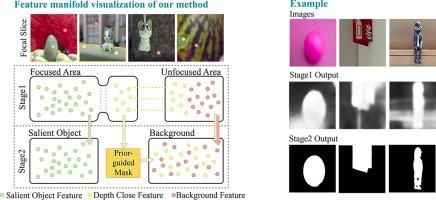Unsupervised saliency detection via multi-focus image reconstruction and prior-guided mask based on light field imaging
IF 3
3区 工程技术
Q2 ENGINEERING, ELECTRICAL & ELECTRONIC
引用次数: 0
Abstract
Recently, light field data has garnered significant attention due to its immense potential in Unsupervised Salient Object Detection (USOD). However, these methods neglect the ability of the light field information itself to generate pseudo-labels. In this paper, we design a two-stage pseudo-label generation framework, based on the data structure of light field. In the first stage, we propose a proxy task called multi-focus image reconstruction (MFIR). It leverages light field information to generate a shallow depth-of-field image with the focus on the salient object, approximating the learning of saliency features. In the second stage, we introduce repair network and prior-guided mask (PGM) to guide pseudo-label updating by leveraging the stability of salient features in pre-trained weights, thereby addressing the depth ambiguity issue arising from MFIR. We name our framework light field refocus for saliency (LFR4S). Additionally, we use the generated pseudo-labels for supervised training and conduct comparative analysis on the results. Experimental results demonstrate that our method surpasses most existing USOD methods across multiple datasets. Finally, we design corresponding ablation studies to verify the necessity of certain modules.

基于光场成像的多焦点图像重建和先验引导掩模无监督显著性检测
近年来,光场数据由于其在无监督显著目标检测(USOD)中的巨大潜力而引起了人们的极大关注。然而,这些方法忽略了光场信息本身产生伪标签的能力。本文设计了一个基于光场数据结构的两阶段伪标签生成框架。在第一阶段,我们提出了一种称为多焦点图像重建(MFIR)的代理任务。它利用光场信息生成聚焦于显著物体的浅景深图像,近似于显著特征的学习。在第二阶段,我们引入修复网络和先验引导掩码(PGM),通过利用预训练权值中显著特征的稳定性来指导伪标签更新,从而解决由MFIR引起的深度模糊问题。我们将我们的框架命名为光场聚焦显着性(LFR4S)。此外,我们使用生成的伪标签进行监督训练,并对结果进行对比分析。实验结果表明,我们的方法在多数据集上优于大多数现有的USOD方法。最后,我们设计了相应的烧蚀实验来验证某些模块的必要性。
本文章由计算机程序翻译,如有差异,请以英文原文为准。
求助全文
约1分钟内获得全文
求助全文
来源期刊

Digital Signal Processing
工程技术-工程:电子与电气
CiteScore
5.30
自引率
17.20%
发文量
435
审稿时长
66 days
期刊介绍:
Digital Signal Processing: A Review Journal is one of the oldest and most established journals in the field of signal processing yet it aims to be the most innovative. The Journal invites top quality research articles at the frontiers of research in all aspects of signal processing. Our objective is to provide a platform for the publication of ground-breaking research in signal processing with both academic and industrial appeal.
The journal has a special emphasis on statistical signal processing methodology such as Bayesian signal processing, and encourages articles on emerging applications of signal processing such as:
• big data• machine learning• internet of things• information security• systems biology and computational biology,• financial time series analysis,• autonomous vehicles,• quantum computing,• neuromorphic engineering,• human-computer interaction and intelligent user interfaces,• environmental signal processing,• geophysical signal processing including seismic signal processing,• chemioinformatics and bioinformatics,• audio, visual and performance arts,• disaster management and prevention,• renewable energy,
 求助内容:
求助内容: 应助结果提醒方式:
应助结果提醒方式:


